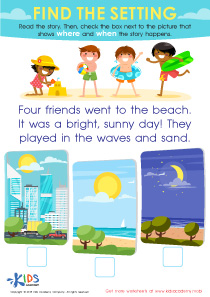Story sequencing Easy Worksheets for Ages 4-5
3 filtered results
-
From - To
Boost your child’s storytelling skills with our "Story Sequencing Easy Worksheets" designed specifically for ages 4-5! These engaging worksheets help young learners understand the importance of narrative order through fun and relatable activities. As children arrange key images or events, they enhance their memory, comprehension, and critical thinking abilities. Our user-friendly resources incorporate colorful illustrations and simple instructions, ensuring that learning is both enjoyable and effective. Perfect for home or classroom use, these worksheets foster creativity while building a strong foundation in literacy. Start your child's journey into storytelling today and watch their imagination blossom!


Folktales Printable PDF Worksheet: The 3 Little Pigs


Rapunzel Story Sequencing Worksheet


Little Red Riding Hood: Illustrations Worksheet
Story sequencing is an essential skill that lays the foundation for early literacy in children ages 4-5. It involves understanding the order of events in a story, helping children grasp the concept of beginning, middle, and end. This skill is crucial for several reasons.
Firstly, story sequencing enhances comprehension. When children can identify sequences, they are better equipped to follow narratives and understand plot developments, crucial for both reading and listening.
Secondly, it fosters critical thinking. As young learners identify key events and their relationships, they develop analytical skills and learn to predict outcomes, nurturing their cognitive development.
Moreover, story sequencing promotes language development. As children retell stories, they practice vocabulary, grammar, and expression, benefiting their communication skills significantly.
Additionally, it encourages creativity. When children create their own stories, using sequencing techniques, they ignite their imagination and discover the power of storytelling.
For parents and teachers, focusing on this skill can lead to vibrant engagement in literacy activities, making learning enjoyable while enhancing educational outcomes. It’s a gateway for children to navigate not just their immediate environment but also the broader world, instilling a lifelong love for reading and storytelling.
 Assign to My Students
Assign to My Students















